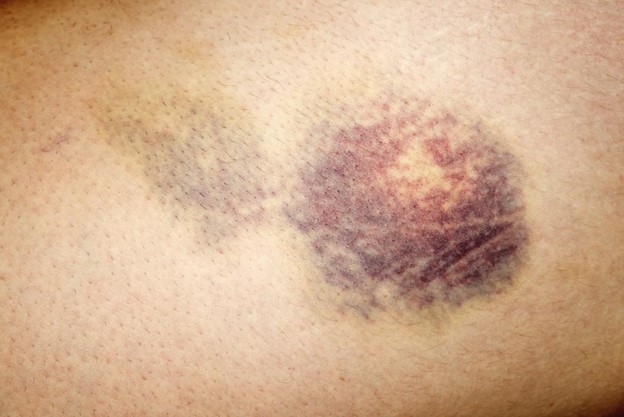A nurse is assessing a client immediately following a cardiac catheterization.
The nurse should notify the provider for which of the following findings?
Heart rate 90/min.
Hematoma over the insertion site.
Bounding pulses in the affected extremity.
Report of discomfort at the insertion site continue.
The Correct Answer is B

A hematoma is a collection of blood outside a blood vessel that can cause swelling, pain, and bruising. It can indicate bleeding from the artery where the catheter was inserted, which can be a serious complication of cardiac catheterization.
The nurse should notify the provider immediately if a hematoma is observed.
Choice A is wrong because heart rate 90/min is within the normal range for adults and does not indicate a complication.
Choice C is wrong because bounding pulses in the affected extremity are expected after cardiac catheterization, as they indicate good blood flow to the area.
Choice D is wrong because report of discomfort at the insertion site is common and usually mild after cardiac catheterization.
The nurse can provide pain relief as needed, but does not need to notify the provider unless the pain is severe or persistent.
Normal ranges for heart rate are 60-100 beats per minute for adults. Normal ranges for blood pressure are 120/80 mmHg or lower for systolic pressure and 80 mmHg or lower for diastolic pressure. Normal ranges for oxygen saturation are 95-100% for adults.
Nursing Test Bank
Naxlex Comprehensive Predictor Exams
Related Questions
Correct Answer is B
Explanation
The correct answer is B. Hip arthroplasty 1 week ago.
Alteplase is a drug that dissolves blood clots by converting plasminogen to plasmin. It can be used for acute ischemic stroke, but it has some contraindications that depend on the indication and the type of administration of the drug. Some common contraindications for alteplase are hypersensitivity, active internal bleeding, history of intracranial hemorrhage, bleeding disorders, and high blood pressure. Other contraindications may vary depending on the specific condition and the time window of treatment. Alteplase can cause serious or fatal bleeding as a side effect.
Choice A is wrong because family history of malignant hypertension is not an absolute contraindication for alteplase, although uncontrolled hypertension (>185 mmHg SBP or >110 mmHg DBP) is.
Choice C is wrong because chronic obstructive pulmonary disease is not a contraindication for alteplase, although it may increase the risk of pulmonary hemorrhage.
Choice D is wrong because acute renal failure 6 months ago is not a contraindication for alteplase, although current use of direct thrombin inhibitors or direct factor Xa inhibitors is.
Normal ranges for blood pressure are <120/80 mmHg for normal, 120-129/<80 mmHg for elevated, 130-139/80-89 mmHg for stage 1 hypertension, and ≥140/≥90 mmHg for stage 2 hypertension.
Normal ranges for platelet count are 150,000 to 450,000 platelets per microliter of blood.
Normal ranges for INR are 0.8 to 1.2 for people who are not taking blood thinners and 2 to 3 for people who are taking warfarin.
Normal ranges for aPTT are 25 to 35 seconds for people who are not taking blood thinners and 46 to 70 seconds for people who are taking heparin.
Correct Answer is ["A","B","C","D","H"]
Explanation
A, B, C, D, and H. Here is why:.
- A. Heart rate: The client’s heart rate is elevated at 118/min, which could indicate blood loss, dehydration, pain, anxiety, or infection. This finding requires immediate follow-up to assess the cause and intervene as needed.
- B. Current medications: The client is taking ibuprofen 800 mg three times daily PRN for arthritis pain. Ibuprofen is a nonsteroidal anti-inflammatory drug (NSAID) that can cause gastric irritation, ulceration, and bleeding. This finding requires immediate follow-up to evaluate the client’s pain level, medication use, and possible alternatives to NSAIDs.
- C. Blood pressure: The client’s blood pressure is low at 90/50 mm Hg, which could indicate hypovolemia, shock, or cardiac dysfunction. This finding requires immediate follow-up to monitor the client’s fluid status, perfusion, and organ function.
- D. Stool results: The client’s stool tested positive for occult blood and H. pylori bacteria. Occult blood indicates gastrointestinal bleeding, which could be related to the client’s abdominal pain and weight loss. H. pylori is a common cause of peptic ulcer disease, which can also cause bleeding and pain. This finding requires immediate follow-up to confirm the diagnosis and initiate treatment with antibiotics and acid-suppressing drugs.
- H. Hemoglobin and hematocrit: The client’s hemoglobin and hematocrit are low at 9.1 g/dL and 27%, respectively. These values indicate anemia, which could be caused by chronic blood loss, nutritional deficiency, or bone marrow suppression. This finding requires immediate follow-up to determine the etiology and severity of the anemia and provide appropriate therapy such as blood transfusion, iron supplementation, or erythropoietin.
The other findings are not as urgent as the ones above:.
- E. Respiratory rate: The client’s respiratory rate is normal at 18/min. There is no evidence of respiratory distress or hypoxia.
- F. WBC count: The client’s WBC count is normal at 6,700/mm3. There is no indication of infection or inflammation.
- G. Temperature: The client’s temperature is slightly elevated at 37.5° C (99.5° F), but not enough to warrant immediate concern. It could be due to stress, dehydration, or a mild infection. The nurse should monitor the temperature trend and report any significant changes or signs of sepsis.
Whether you are a student looking to ace your exams or a practicing nurse seeking to enhance your expertise , our nursing education contents will empower you with the confidence and competence to make a difference in the lives of patients and become a respected leader in the healthcare field.
Visit Naxlex, invest in your future and unlock endless possibilities with our unparalleled nursing education contents today
Report Wrong Answer on the Current Question
Do you disagree with the answer? If yes, what is your expected answer? Explain.
Kindly be descriptive with the issue you are facing.
